Japanese
English
- 有料閲覧
- Abstract 文献概要
- 1ページ目 Look Inside
目的:冠攣縮性狭心症(VSA)の危険因子を,マグネシウム(Mg)欠乏を含めて検討する.方法:VSA患者18名(攣縮群)とエルゴノビンにより冠攣縮が誘発されなかった胸痛患者13名(非攣縮群)を比較して,冠攣縮の危険因子を検討した.Mg負荷試験によってMg欠乏の有無を判定し,その関与も併せて検討した.結果:単変量解析では,喫煙者(55.6%vs23.1%),低HDL血症(50.0%vs15一4%),Mg欠乏者(38.9%vs7.7%)が攣縮群で多い傾向であった(p<0.10).ロジスティック重回帰分析による冠攣縮へのオッズ比は,喫煙が有意に1より大きく(オッズ比:34.56,95%信頼区間:1.75〜679.54),Mg欠乏(オッズ比:13.73,90%信頼区間:1.25〜150.70)が1より大きい傾向を示した.結語:喫煙およびMg欠乏が冠攣縮性狭心症の危険因子である可能性が示唆された.
To determine the role of usual coronary risk factors and magnesium deficiency in vasospastic angina, 18 patients with vasospastic angina without fixed stenosis of coronary arteries (VSA group) were compared with 13 controls with neither fixed coronary stenosis nor ergonovine-induced coronary artery spasm (non-VSA group). Magnesium deficiency was diagnosed when the 24-hour magnesium retension amount was 50% or higher in the magnesium loading test.
In univariate analysis, subjects with magnesium deficiency (38.9% vs. 7.7%), low level of serum high-density lipoprotein (HDL) cholesterolemics (50.0% vs. 15.4%) and current smokers (55.6% vs. 23.1%) tended to be more frequent in the VSA group than in the non -VSA group (p<0.10), whereas other usual coronary risk factors were not different between the groups (p≧0.10). To calculate adjusted odds ratios and the confidence intervals for VSA by smoking, and low HDL cholesterol and magnesium deficiency, we applied a multivariate logistic regression analysis, in which all three factors and age were adjusted. The adjusted odds ratio and 95% confidence interval among smokers was 34.56 and 1.75-679.54, respectively. The adjusted odds ratio and 90% confidence interval in cases where there was magnesium deficiency was 13.73 and 1.25~150.70, respectively. The adjusted odds ratio for low HDLC was statistically insignificant (p≧0.10).
From these results, smoking and magnesium deficiency appeared to be possible risk factors for vasospastic angina.

Copyright © 1996, Igaku-Shoin Ltd. All rights reserved.


